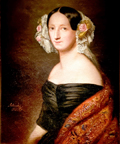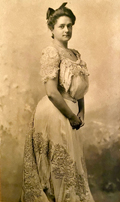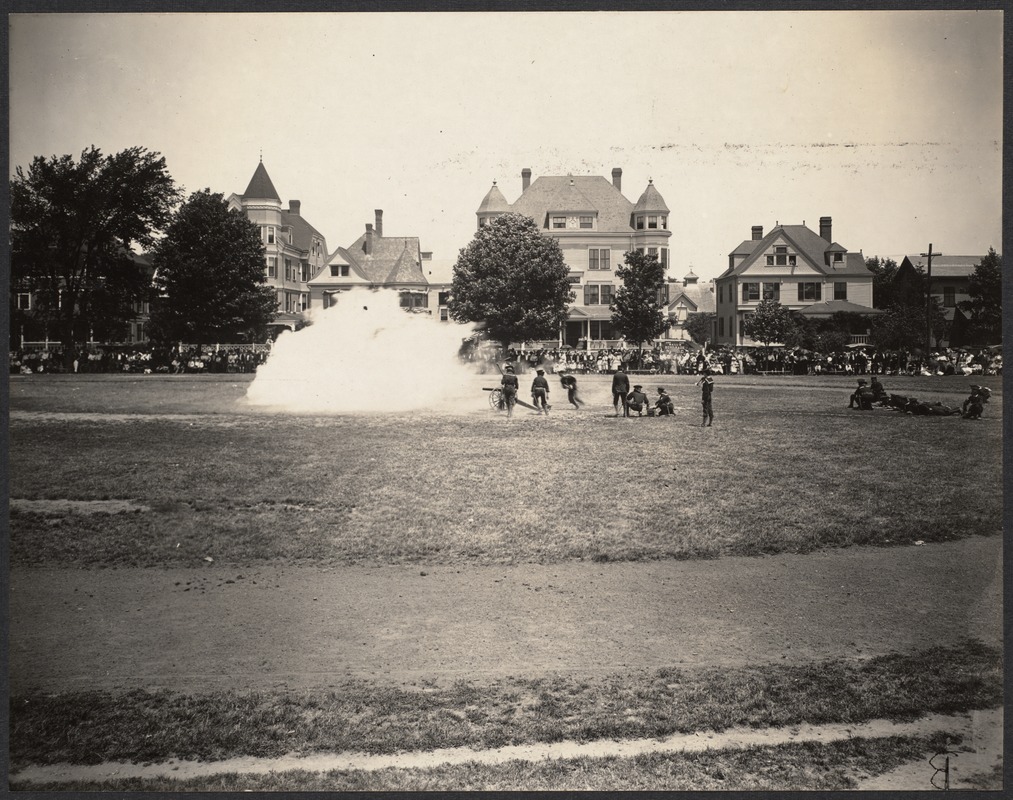 |
Ellen Griggs, Portrait, 1842
Ellen Griggs (1824-1904) was the daughter of prominent town citizen, Deacon Thomas Griggs, who lived on the Griggs Farm located in the area of today’s Grigg Park. Widowed and living in Troy, NY at the time of her father’s death, in 1886, she moved back to Brookline into the family house at 519 Washington Street.
[Source: Saxe Family Collection]
|
 |
Ellen Griggs Saxe and Children
Ellen Griggs Saxe was the daughter of a prominent town citizen, Deacon Thomas Griggs. Widowed and living in Troy, NY at the time of his death, in 1886, she moved back to Brookline into the family house at 519 Washington Street which she had inherited. Family members assembled here are, from left to right:
- John Walter Saxe (standing), 1863-1929, non-identical twin of James Alfred Saxe. The twins both graduated from Harvard College in 1888 and Harvard Law in 1892, and went into business together in Boston as Saxe and Saxe.
- William Arthur Saxe (seated): 1857-1917. He was struck and killed by an automobile in Baltimore where he was secretary/treasurer of a concrete company.
- Mary Ellen Saxe (standing), 1865-1903. She never married and died of pneumonia at the age of 37.
- Ellen Griggs Saxe (seated), 1824-1904
- James Alfred Saxe, 1863-1948, non-identical twin of John Walter Saxe. The twins both graduated from Harvard College in 1888 and Harvard Law in 1892, and went into business together in Boston as Saxe and Saxe.
- Edward Thomas Saxe, 1860-1924, partially visible. Lived for years on Aspinwall Ave.
[Source: Saxe Family Collection]
|
 |
Sarah Florence Burtis
Her engagement photo. She married John Walter Saxe in 1899 and the family with three children lived at 424 Walnut St. from circa 1905-1912
[Source: Saxe Family Collection]
|
 |
637, 643, 655 Washington St.
From left to right:
- 655/657 Washington St., partial view, house still standing
- Gasometer. This was the last of four gasometers built by The Brookline Gas Co. to store gas to run gas street lamps. This one was built in 1872 and demolished in 1984. By 1917, it had been converted to a succession of purposes. Here it is being used by a service station.
- 637 Washington St., still standing after major renovations.
[Source: Brookline Preservation Department]
|
 |
Washington St., Before 1940
In the distant rear, on Corey Hill, two houses are viewed. Left to right:
- 1600 Beacon St., Eben Jordan Mansion, later the Choate School, no longer standing
- 57 York Terrace, the house high on the hill with the tall tower, still standing, the tower was removed in 1938
In the middle of the photo are the rear of the buildings on the south side of Beacon St., several are still standing including the tall apartment building at 1569-1571 Beacon St.
In the foreground is the last of four gasometers built by The Brookline Gas Co. to store gas to run gas street lamps. This one was built in 1872 and demolished in 1984. By 1917, it had been converted to a succession of other uses. Here it is being used by a service station and garage. On the right is a partial view of 637 Washington St., still standing after major renovations.
[Source: Brookline Preservation Department]
|
 |
The Farm, 1958
Viewed from Parker Hill.
[Source: Brookline Preservation Department]
|
 |
645/647 Brookline Ave., January 1966
From a notebook of property-appraisal photos taken in 1965 and early 1966 for “The Marsh Urban Renewal Project” run by the Brookline Redevelopment Authority. Only a few scattered peripheral structures remain today.
|
 |
682/684 Brookline Ave.
Looking east. Gulf service station on the corner of Lower Washington St. is on the right. This photo was taken prior to the leveling of the entire area then known as “The Marsh”.
From a notebook of property-appraisal photos taken in 1965 and early 1966 for “The Marsh Urban Renewal Project” run by the Brookline Redevelopment Authority. Only a few scattered peripheral structures remain today.
|
 |
647, 651, 657 Brookline Ave., January 1966
Looking from right to left. This photo was taken prior to the leveling of the entire area then known as “The Marsh”.
From a notebook of property-appraisal photos taken in 1965 and early 1966 for “The Marsh Urban Renewal Project” run by the Brookline Redevelopment Authority. Only a few scattered peripheral structures remain today.
|
 |
657 Brookline Ave.
On the left is Emerald St. looking west toward Pearl St. On the corner is 657 Brookline Ave. followed by #651 and a partial view of #647.
[Source: Brookline Preservation Department]
|
 |
Brookline Village
Looking northeast from Washington St. Foreground left: the curve of Prospect St. preceding the First Presbyterian Church, built in 1897, no longer standing. Rear, left: The large brick apartment building at 152-158 Harvard St., built circa 1900. Rear, left of center: The steeple of the Harvard Congregational Church with the cupola of the Pierce Buiding in Coolidge Corner just visible to its immediate left. Center: white apartment buildings sandwiched between Aspinwall Ave. and Homer St. Foreground, right: St. Mary's of the Assumption Church. The steeple is on Harvard St.
[Source: Digital Commonwealth]
|
 |
170 - 201 Davis Ave.
Looking north at Davis Ave., all the houses are still standing. Behind the crowd, center photo, is a wagon advertising “Balls’ Homemade Bread” which was a business in Cambridgeport during the 1890s. From left to right:
- 201 Davis Ave., hidden behind trees
- 195 Davis Ave., partial view.
- 191 Davis Ave. with the double towers
- 185 Davis Ave.
- 181 Davis Ave.
- 179 Davis Ave.
[Source: Digital Commonwealth]
|
 |
Emerald St.
9 Emerald St. is on the left, sideview of 657 Brookline Ave. is on the right. This photo was taken prior to the leveling of the entire area then known as “The Marsh”.
From a notebook of property-appraisal photos taken in 1965 and early 1966 for “The Marsh Urban Renewal Project” run by the Brookline Redevelopment Authority. Only a few scattered peripheral structures remain today.
|
 |
9 Emerald St., January 1966
657 Brookline Ave. is on the right.
From a notebook of property-appraisal photos taken in 1965 and early 1966 for “The Marsh Urban Renewal Project” run by the Brookline Redevelopment Authority. Only a few scattered peripheral structures remain today.
|
 |
Emerald St.
Looking east on Emerald St. from Pearl St. toward Brookline Ave. before the leveling of the neighborhood in the urban renewal project of “The Marsh”. From left to right:
- 9 Emerald St., the small house
- 657 Brookline Ave. on the corner
- 660 Brookline Ave.
- 666/670 Brookline Ave.
- Partial view of the auto garage at 676 Brookline Ave.
- A town truck parked at the Brookline Water Dept., a building that still stands
[Source: Brookline Preservation Department]
|
 |
Harvard St.
Looking north on Harvard St. from Harvard Sq. On the left is the rear of the Rhodes supermarket which opened at the beginning of 1906, the house at 20 Harvard St. and the Baptist Church.
[Source: Brookline Preservation Department]
|
 |
10 and 14 Pearl St.
Looking toward Lower Washington St. with the rear of the White Castle restaurant visible in the distance. On the right are 10 and 14 Pearl St. William Francis Conant, the long-time owner of The Brookline Print, had recently been living upstairs in this building with his third wife, Adelaide Huestis Conant, when he died in 1959. This photo was taken prior to the leveling of the entire area then known as “The Marsh”.
From a notebook of property-appraisal photos taken in 1965 and early 1966 for “The Marsh Urban Renewal Project” run by the Brookline Redevelopment Authority. Only a few scattered peripheral structures remain today.
|
 |
21 Pearl St.
Looking south at 21 Pearl St. On the right, where Pearl St. turns left toward Lower Washington St., is the building at 10-14 Pearl St. This photo was taken prior to the leveling of the entire area then known as “The Marsh”.
From a notebook of property-appraisal photos taken in 1965 and early 1966 for “The Marsh Urban Renewal Project” run by the Brookline Redevelopment Authority. Only a few scattered peripheral structures remain today.
|
 |
Pearl St.
Looking east on Pearl St. from 21 Pearl St. Six houses on the left, from #24- #38, were removed circa 1960 and replaced with the parking lot next to the Longwood stop on the “D” line. In the distance is the massive depot building of the Brookline Coal Co. at 42 Pearl St. dwarfing the small building at 40 Pearl St.
[Source: Brookline Preservation Department]
|
 |
Longwood MBTA Stop, 1960s
Standing on the Washington St. bridge looking east on the tracks of the “D” line by the Longwood stop. In the distance is the massive depot building of the Brookline Coal Co. at 42 Pearl St.
[Source: Brookline Preservation Department]
|